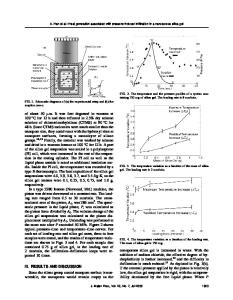Effects of addition of ethanol on the infiltration pressure of a mesoporous silica
- PDF / 1,272,764 Bytes
- 4 Pages / 612 x 792 pts (letter) Page_size
- 108 Downloads / 288 Views
The energy absorption behaviors of mesoporous silica particles immersed in aqueous solutions of ethanol were investigated. Addition of ethanol could significantly lower the infiltration pressure, which has great potential in developing selective protection systems. The ethanol concentration of the confined liquid inside the nanopores was higher than outside.
I. INTRODUCTION
Developing nanoporous technologies has been an active research area for many years.1 A number of techniques have been established to synthesize microporous, mesoporous, and macroporous materials with various pore sizes, specific areas, surface properties, and pore structures. They have been widely applied in catalysis, selective absorption, and purification processes.2,3 Recently, a novel application of nanoporous materials in advanced protection devices has drawn increased attention.4–7 When hydrophobic nanoporous materials, e.g., silicalites or nanoporous silicas, are immersed in water, at the atmosphere pressure pat, the liquid phase cannot enter the nanopores due to the capillary effect. As the pressure increases to a critical value pin, the pressureinduced infiltration can occur. As the pressure is reduced back to pat, for reasons that are still under investigation, the confined liquid remains in the nominally energetically unfavorable nanopores and, therefore, the excess solid–liquid interface energy cannot be released. Since the specific areas of the nanoporous materials are usually in the range of 100–1000 m2/g, the effectiveness of energy absorption of such systems can be much higher than that of conventional energy-absorbing materials such as reinforced polymers and shape memory alloys.8,9 This technique has immediate applicability in the development of “liquid armors,” programmable catalysis, and other areas.10,11 One of the vital factors dominating the system performance is the infiltration pressure pin. In an impact test, only the energy carried by the portion of incident pulse with the pressure higher than pin can be dissipated by the
a)
Address all correspondence to this author. e-mail: [email protected] DOI: 10.1557/JMR.2005.0140 1042
http://journals.cambridge.org
J. Mater. Res., Vol. 20, No. 4, Apr 2005 Downloaded: 22 Mar 2015
nanoporous system; that is, the energy absorption is selective. This characteristic is beneficial to minimizing the weights and sizes of the protection systems that can filter out the “peaks” of stress waves. However, currently, the researches in this area are limited to systems based on pure water, in which pin is primarily determined by the surface-treatment techniques and the pore sizes. To adjust the infiltration pressure in a broader range, in the current study, we investigated the effects of addition of chemical admixtures. II. EXPERIMENTAL A. Choice of materials
The admixture should have the following characteristics: (i) the molecules are much smaller than the pore size such that the “repelling” effect is negligible;12 (ii) the molecules are capable to form strong bonds with water; and (iii)
Data Loading...










